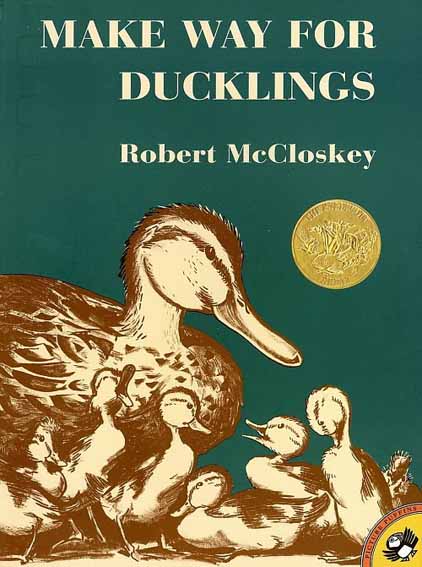
1. BIBLIOGRAPHY
McCloskey, Robert. 1941.
MAKE WAY FOR DUCKLINGS. Ill. by
Robert McCloskey. New York, NY: Viking
Press. 059033494
2. PLOT SUMMARY
Mr. and Mrs. Mallard are looking for an ideal
and safe location to raise their ducklings.
They scout several places in Boston, Massachusetts, like Public Garden,
Beacon Hill, and Louisburg Square, but finally decide on an island near the
Charles River because of its tranquility and human hospitality. As they wait for the ducklings to hatch, they
make friends with a police officer named Michael, who feeds them peanuts every
day. After the babies arrival, Mr.
Mallard decides to explore the city more and Mrs. Mallard readily agrees to
raise them on her own for a week. As
Mrs. Mallard and her eight ducklings make their way to meet Mr. Mallard on an
island near the Public Garden, they run into some difficulty in trying to cross
the highway safely. Luckily, their
policeman friend, Michael, ushers them safely across and even calls police
headquarters so that other officers will help them in the Mallards journey.
After thanking the police officers, Mrs. Mallard and her eight ducklings meet
with Mr. Mallard and make the new island their home.
3. CRITICAL ANALYSIS
This heart-warming story is told using a combination of
simple sentences with longer, worded sentences, all used to drive the momentum
of the story forward. By using this
alternation in sentence structure, McCloskey keeps his readers engaged as they turn
the pages to find out what happens next in the Mallard's family journey. For example, short simple sentences are used
when describing the ducklings upbringing, and readers must turn the page to see
how the ducklings are learning and growing.
McCloskey also effectively uses hard page breaks with punctuation to
keep his readers attention. This is
evident with a page ending with the word "But-", and when readers
turn the page, they see a little boy racing through the streets on his bicycle,
nearly hitting Mr. Mallard. In another example, the comma is
used to break a sentence onto two pages, with one page ending with "The
policemen held back the traffic so Mrs. Mallard and the ducklings could march
across the street," and continuing onto the next with "right into the
Public Garden."
The brown colored, charcoal drawings portray realistic
details in the ducks' body structure and movement, and also capture the many
settings of Boston where the story occurs.
McCloskey brings Boston to life in his drawings with they city's brownstone
buildings, Victorian row homes, and stone arched bridges. From the illustrations, readers are able to
determine that the story occurs in the past, perhaps during the nineteen
forties, based on the car models shown in the streets as well as the clothing
attire worn by the town citizens and police officers. The brown charcoal drawings are also used to
show the characters' expressions, such as Mrs. Mallard's proud, up-turned face,
as she defiantly marches across the crowded street, Michael's concerned and
scared look as he hurriedly dials headquarters for help, and the surprised and
astonished faces of the town's citizens as they look on the Mallard family. Readers sense the urgency and real danger the
Mallard family is in as they try to cross the busy street when McCloskey uses
bold, capital letters to spell out " HONK!" and "QUACK!" in
the illustrations.
Although the story does use traditional stereotype roles for
the male and female of the family (with the father leaving to work and the mother left with to raise the
children), Mrs. Mallard is anything but passive and meek. She is portrayed as strong and independent, demanding the best for her children, and stopping at nothing to ensure the safety
and security of her family. This
touching story captures the love and caring parents have in raising their
children. Young children can relate to
it because they see the lengths their parents will go to, to keep them safe
from harm. It also relates to children
the importance of helping others, like Michael and his fellow police officers did
to ensure the Mallard's safety.
4. REVIEW EXCERTS
1942 Caldecott Award Book
SCHOOL LIBRARY JOURNAL: "McCloskey's attention to detail and marvelous storytelling are a magical combination."
PENGUIN GROUP: "Starting and ending with adorable
ducklings, this 60-year old story is still as charming today as it was when
Viking first published it in 1941. A true classic, Make Way for Ducklings is
sure to win yet another generation of fans!"
5. Connections
*Discuss with young students the importance of safety when
crossing the streets. What should they
do first? Where or who can they go to if
they need help?
*Have students strengthen their map skills by printing out a
copy of the Boston city streets and have them pinpoint the Mallard family's
journey. Then print out a copy of your city's streets and have the students map
out a safe journey the Mallard family may take within the city limits.
* Have students study the characteristics of Mallard ducks
using the National Geographic website http://animals.nationalgeographic.com/animals/birds/mallard-duck.html
No comments:
Post a Comment